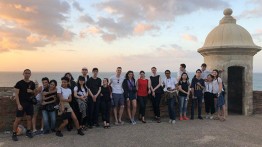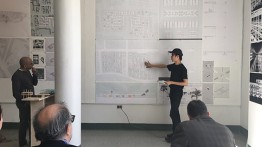Shelter from the Storm: Cooper Architects in Puerto Rico
POSTED ON: September 14, 2018
Housing—how to build it in a way that’s affordable, humanistic, and supportive of community—was a central question of architectural debate throughout the 20th century. Add to that list a more recent concern with sustainability in the face of climate change, and you have a complex puzzle requiring both sensitivity and practicality, a combination that, as many high-rises and housing developments reveal, has often gone missing.
Few places today demonstrate exactly how important all of these elements are to thriving communities more than Puerto Rico, where 3.3 million citizens face extreme hardship due to hurricanes Irma and Maria in the fall of 2017 and the island’s pre-existing debt crisis, which, among other factors, has hamstrung recovery efforts. Although the official death toll is 64, the New England Journal of Medicine reported that there were 4,600 more deaths from October to December 2017 than there were in the same period the year before. As of the end of May 2018, many people still had no running water and almost 14,000 had no power, the hardest hit being those outside urban areas. It is the longest-running major power outage in United States history.
With that in mind, Lorena del Rio, Mersiha Veledar, and Kevin Bone, professors in The Irwin S. Chanin School of Architecture, challenged this past year’s third-year students to research, contemplate, and respond to the crisis by designing housing that included strategies to mitigate the impact of storms past and future. The studio was organized in collaboration with the University of Puerto Rico (UPR), so students traveled to the island, where they saw firsthand some of the challenges to designing in a world of rising temperatures and debt.
“The advent of the hurricane offered an opportunity to engage in a social project that could make both immediate and long-term contributions to the island, but also to the discipline,” says Nader Tehrani, dean of the school of architecture. And the results of the studio proved him correct. Del Rio says that students responded to “the urgency of the topic” and grew passionate about the injustice of circumstances in Puerto Rico even many months after the hurricanes. One student, Dylan Dewald, describes the impact of the trip: “Visiting our colleagues in Puerto Rico made me realize how deeply rooted the problems are. Hurricane Maria is just the tip of the iceberg, as almost a century of American involvement on the island has severely limited its economic growth.”
Veledar recalls that after the faculty held workshops to plan the studio, “we agreed to follow an identical programmatic approach between UPR and The Cooper Union, with a focus on ‘housing’ as an essential program that necessitated a new approach in the context that has endured tremendous environmental destruction.”
The studio was designed as a quick progression to give students a breadth of knowledge about the history of Puerto Rico, both natural and political. The first week, students produced context analyses in which each investigated an aspect of the island—its resources, topography, and culture— and then developed ideas about incorporating productive activities back into the urban fabric: anything from making music and art to cultivating local medicinal plants to creating locally owned business. The thinking was that since so much of Puerto Rico’s culture had been subsumed by American industrial organization, locals have lost traditional forms of production and the means to provide for themselves. The coffee industry provides a prime example: coffee crops were once grown primarily for export; Puerto Ricans had to drink coffee grown elsewhere that was imported to the island. Similarly illogical arrangements inform multiple industries.
For that first project, students illustrated their findings on a host of topics, including migration patterns, agriculture, and land division in Puerto Rico. Dylan researched the island’s pharmaceutical industry, which once received massive tax breaks for relocating there allegedly to create highly skilled jobs for Puerto Ricans. Dylan learned that the expected return has not been realized, and set out to create a housing scheme that builds on knowledge of traditional herbal medicine.
His classmate Zhenia Dementyeva investigated a vernacular form of gardening and farming particular to Puerto Rico called canuco, a technique in which discarded fabric is buried to act as an anchor for plants grown on sloped land. It’s a method particularly useful for preventing erosion and catching rain- water. “This ingenious plan inspired the roofscape of my project,” she says, referring to her final proposal in which she carefully calculated the amount and direction of sunlight to design where each apartment’s garden would be situated.
Students also researched well-known houses and buildings largely from the 20th century, a survey that included Alison and Peter Smithson’s Robin Hood Garden Apartments (1972), Luigi Moretti’s Casa II Girasole (1950), and Kazuyo Sejima and Ryue Nishizawa’s Gifu Kitagata (2009). Then they embarked on a study of the specific site in San Juan and of building systems that would work best for the climate.
The site, in the east San Juan neighborhood of Turce, is divided into seven segments and includes three public schools, a park, and, on the north side, a public beach (which is rare—most in the area are open only to hotel guests). The highway Calle Marginal defines the southern boundary of the site. To the southeast is Residencial Luis Llorens Torres, the largest public housing development in Puerto Rico, with a long and troubled history of violence and drug dealing. Because of its proximity to the sea, the site is regularly flooded. After Hurricane Maria, the waters took four weeks to recede from the park.
During Cooper’s spring break last March, del Rio and Veledar traveled with their students for five days in Puerto Rico, moving at a breakneck pace around the island, to see as much as possible of the landscape, housing, and culture there while collaborating with their colleagues. “They of course brought a great deal of knowledge to the table about the politics of the island as well as the housing needs of Puerto Ricans,” says del Rio of the 48 UPR students.
As they traveled from San Juan to the center of the island, down to Ponce and then back to the capital, the Cooper students discovered that despite the great damage done, scores of people have found creative ways to survive, and even more, to alter power structures, physical and political. The best example of this is Casa Pueblo, a community in the center of the island that has played a critical role in the post-Maria recovery. A coffee plantation that produces its own energy using solar panels, the collective became a haven for people who had lost power after the storm, providing them with solar- powered lights and refrigerators. Additionally, in an effort to question and even counter Puerto Rico’s dependence on American industrial demands, some young people have taken up small-scale farming.
José Javier Toro, a professor from UPR’s School of Architecture, helped design the course with colleagues there and at Cooper. He noticed that the two sets of students tended to create divergent solutions to the design problem at hand, though he cautioned that the work should not be compared since the two groups’ approaches were rooted in very different experiences. “Naturally, the local students had lived through the difficulties during and after the storms. This greatly affected their perspective, their studies, their capability to complete work, and perhaps made them work with a greater sense of urgency and maturity,” he says. Nonetheless, he thought the camaraderie among the student groups was exemplary, and had an enthusiasm beyond that found in most studio courses.
Once back in New York, students started to design housing that would integrate their proposals for productivity now that they had visited the site. For his project, Dylan decided to invert the hiring practices of pharmaceuticals that use Puerto Ricans for manual jobs, leaving the white-collar positions to outsiders. He designed social housing that, as he put it, brings “jobs that require specialized knowledge of naturally occurring medicinal herbs in Puerto Rico.” He chose to work on a segment of the site that divides a wealthy, gated community from a poor neighborhood. The medicinal plants would act as a spatial and metaphoric salve for what he calls “a wound in the urban fabric of San Juan.”
Cheung Lun Jeremy Son, a third-year student from Hong Kong, developed the southwest corner of the site. Inspired by Luigi Moretti’s Corso Italia, Le Corbusier’s Unité d’habitation, and the mobile architecture of Yona Friedman, he proposed a steel structural frame that could be arranged in multiple ways to suit changing housing, commercial, and educational needs. “The scheme is to create a structural urban framework that anticipates housing units, commercial activities, and educational institutes as an evolving mechanism that could expand or contract as necessary over time,” Jeremy explains. “It is designed to be carried out periodically in phases. Residents shape their housing to their needs and thus shape their neighborhood.” In addition, he sees the frame as a way for the site to remain open to the rest of the city, countering the trend toward gated neighborhoods that promote exclusivity. All public, commercial, and cultural activities were placed on the ground floor of the housing development, but living spaces were elevated for greater privacy.
Jeremy found that despite the many sources available on the internet, nothing could replace actually visiting the site. “The visit allowed me to truly understand the impact of natural forces on existing infrastructures. Through the trip, I could observe and learn about the common materials and techniques they employ that respond to their socio-economic, public safety, and climatic condition.”
An exhibition of the students’ work in the Houghton Gallery, “Productive Hybrids: Design III Urban Housing in San Juan,” ran from April 10 to 27, letting viewers see the students’ work as it developed, including their context studies and their proposals for the site. On April 24, a panel discussion with del Rio and Veledar along with prominent architects and planners was held in the gallery in conjunction with the studio exhibition. Moderated by Professor Diana Agrest, participants included Michael Marrella, New York City’s director of waterfront and open space planning, architect Jonathan Marvel, and Catherine Seavitt Nordenson, a 1994 graduate of the school of architecture who has long been writing about and designing for coastal resilience. Tehrani says, “We took this occasion to create a smaller panel to open up dialogue on the challenges of these projects to gauge the various debates within which architecture is implicated. I would like to see other roundtables like this in the coming years.”
As a native of West Bloomfield, Michigan, where the stand-alone house represents the ideal housing type, Dylan notes that the studio gave him newfound understanding of the value of the density typical of apartment living: “Social housing,” he says, “gives the opportunity to create empowered spaces that are formed by the interaction between units and fosters intimate relationships among residents that solitary houses could never accomplish.” The result, he thinks, is something greater than any one house or apartment: a means for building a community organized, sustainable, flexible, and self-reliant enough to better meet the physical— and political—challenges of future storms.








